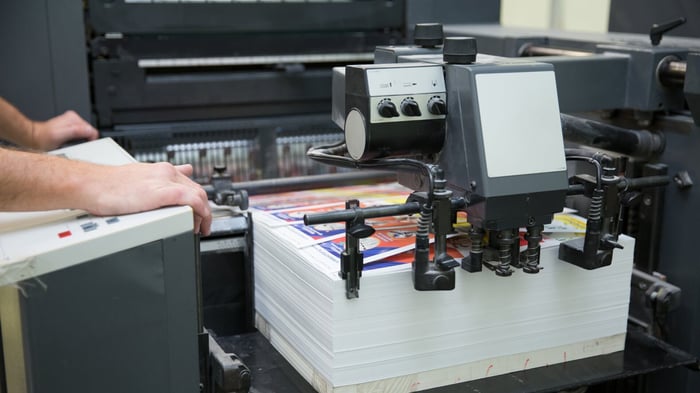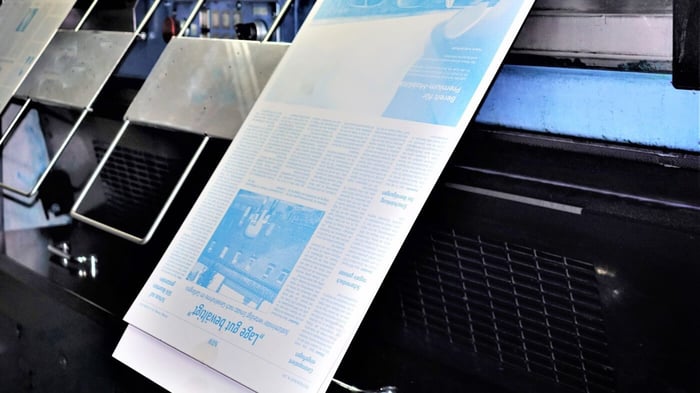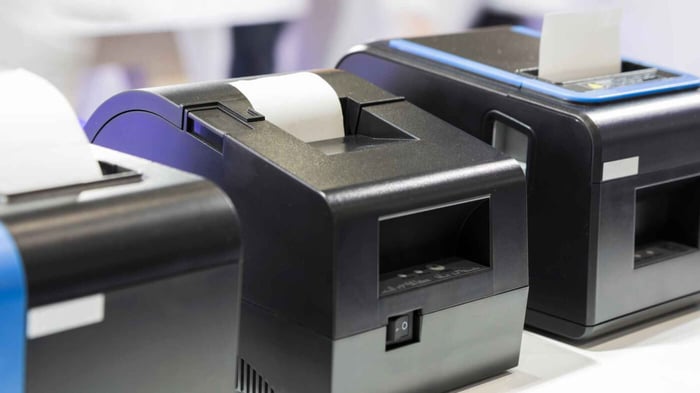Printing plates are thin, flat sheets of metal, typically made of aluminum, used in traditional printing processes such as offset printing. The image or design to be printed is etched onto these plates, which are then used to transfer the ink to the paper.
Printing plates might seem simple, but they’re central to the print world. These thin metal sheets, often aluminum, are used to transfer text and images onto products like business cards, brochures, and catalogs. You might not notice them in action, but they’re critical for getting vibrant colors and crisp lines onto paper.
How do they do it? By carrying your digital design, etched into the plate, so the press can apply the exact amount of ink in the right places. It’s a straightforward idea with a big impact on the prints you see around you every day.
Let's explore.
The Role of Printing Plates in Offset Printing
Offset printing is popular for large print runs. Think of thousands of catalogs that need consistent color from the first copy to the last. Each color in your design gets its own plate, so if you're printing a four-color job (cyan, magenta, yellow, and black), you'll have four plates ready to go.
The plates are secured on rotating cylinders inside the press. As it runs, water keeps the areas that shouldn’t print from holding ink, while the etched design grabs the ink and then presses it onto a rubber blanket. That blanket, in turn, presses the image onto the paper. It might sound a bit roundabout, but it gives you sharp and detailed results again and again.
The Process of Offset Printing
Offset printing primarily depends on printing plates to transfer your design onto paper. It's a fascinating process where science meets art.
In this process, the ink and water interact with the printing plate so that the ink adheres only to the areas where your design is etched, while the rest of the plate is kept ink-free by a thin film of water. This enables the plates to deliver the design precisely onto the paper.

How are Printing Plates Made?
The making of printing plates primarily involves a process known as prepress production. This is the term used for all the processes between creating a print layout and the final printing.
To begin, a design is created digitally using design software. Once this design is complete and the layout finalized, the digital file is processed in a prepress software. This software converts the information into a format that can be understood by the printing press.
The next step in the process is to make the actual plates. Nowadays, this is typically done using Computer-to-Plate (CTP) systems. These systems eliminate the need for having an additional film plate in the process, thus improving the sharpness and detail of the final printed images.
A CTP system outputs an image directly onto the printing plates. These plates are coated with a light-sensitive material, and a thermal laser is used to image the plate according to the digital data received.
The laser etches the image onto the plate by hardening the light-sensitive coating wherever it is exposed. The unhardened areas that weren't exposed to the laser are then removed. This leaves the hardened, etched areas, creating the image areas that will accept ink.
In full-color (CMYK) printing, a separate plate is created for each color: cyan, magenta, yellow, and key (black). Each plate is then loaded onto a unit on the printing press, and these work in unison to lay down the correct combination of these four colors, resulting in the full-color image on the printed material.
Once the plates are made, they are carefully loaded onto the press and the printing process can begin. After printing is completed, the plates are cleaned off and can be reused if the same job needs to be printed again in the future. If not, they are recycled according to environmental regulations.
So, while creating printing plates involves a complex process, it's essential to achieving high-quality printed materials. The evolution of technology, particularly with CTP systems, has made this process more precise, efficient, and eco-friendly than ever before.
Ever wondered why printing plates are often blue? In modern-day printing, CTP (computer-to-plate) machines are used. These machines utilize laser technology to etch the designs onto the printing plates. The blue sections of the plate guide where the ink should be applied as the cylinders contact the paper. So, don't worry! This blue color will not affect your design's output unless it is supposed to be blue.
Understanding CTP (Computer-to-Plate) Machines
CTP machines have become a cornerstone of modern printing. They rely on laser technology to etch designs onto printing plates, which helps ensure each print is clean, precise, and faithful to the original file. This process replaces older methods that needed extra steps like creating film negatives. By skipping the film stage, CTP machines reduce waste and cut down on errors.
Even though printers handle the plate-making process, customers share responsibility too. They need to provide well-prepared digital files with the right resolution, color settings, and bleed margins. If any of these details are off, the finished plates—and ultimately the printed materials—won’t look right. So it’s a joint effort that brings the final result to life.
Is Money Printed Using Printing Plates?

Currency involves plates too, but the printing process is more specialized. Most banknotes are made with intaglio printing, where designs are engraved into metal. Ink fills the grooves, and high pressure transfers those details onto the paper, leaving a slightly raised texture.
This raised texture isn’t just for show—it’s one of several anti-counterfeiting measures. Watermarks, color-shifting ink, and unique serial numbers add more layers of security.
Once the printing is done, the plates are carefully tracked and eventually destroyed, which helps prevent misuse.
Can Plates Be Reused?
Yes, if you plan to reprint the same design in the future, you can store and reuse the plates. They just need a thorough cleaning to remove ink residue. Some printers hang onto plates for major clients, so they can quickly set up another run. But if a design changes, new plates must be created. When plates become obsolete, they’re often recycled because aluminum can be repurposed. It’s nice to see the printing industry leaning towards more sustainable solutions.
Behind the Scenes of a Big Print Run
Imagine you’re printing 10,000 brochures. The design was finalized a week ago, and today the plates are ready. You load each color plate into its own unit on the press. You line up the paper supply, verify the ink levels, and check that the feeder rollers don’t jam. Once everything’s in place, you hit “go,” and paper zooms through the press. Within minutes, finished brochures are stacking up at the end of the line. If there’s a smudge or misalignment, you have to pause and figure out the problem. Sometimes a bit of dust or dried ink can foul the process. It can be frustrating, but it’s all part of getting a perfect final product.

Conclusion
Understanding the role of printing plates can give us a fresh perspective on the art of print media. These vital components play a crucial role in offset and CMYK printing processes, delivering high-quality prints for a variety of products. Whether it's for business cards, brochures, or catalogs, remember that the magic of print media begins with these fantastic aluminum sheets.
FAQs
Why are printing plates made of aluminum? Aluminum is used because it's lightweight, durable, and holds up well under the high pressure and speed of printing presses.
Can I use my own printing plates for a print job? Typically, the printer handles the creation of printing plates. Customers are only required to provide their digital files.
How are colors separated for printing? Colors are separated using the CMYK process. Each color—cyan, magenta, yellow, and key (black)—is represented by a separate printing plate.
What is a CTP machine? A CTP (Computer-to-Plate) machine uses laser technology to accurately etch designs onto printing plates.
Does the color of the printing plate affect the final print? No, the color of the printing plate does not affect the final print. The blue color on the plate simply guides where the ink should be applied during printing.






